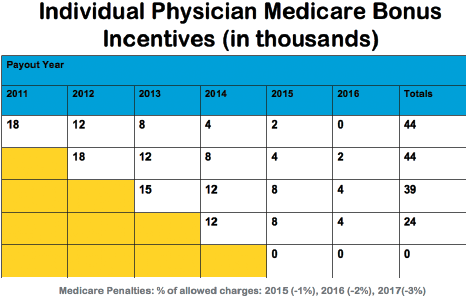This is the final installment in a three-part part series on the meaningful use of health information technology. Last month (April 22 issue), I outlined how chiropractors are going to accomplish meaningful use of a certified electronic health records (EHR) system.
By the way, I just returned from a trip to Washington, D.C., and to Atlanta, where I met with a policy analyst from Health and Human Services with the Office of the National Coordinator for Health Information Technology and was able to clarify some areas that needed more definition. Next month, our discussion will continue with a final summary and commentary based on the latest government information.
What We Know So Far
All physicians are facing a unique opportunity over the next five years through the American Recovery and Reinvestment Act (ARRA), also known as the HITECH Act.) Medicare has allocated up to $44,000 in incentive payments available for early adopters of EHRs. In order to qualify for incentive payments, the provider must:
- Adopt a certified EHR system. These certified systems have not been announced or certified. It is expected that by the fourth quarter of 2010, the list of software systems that are certified will be published on the Office of the National Coordinator for Health Information Technology (ONC) Web site.
- Demonstrate that their practice is using a certified EHR in a meaningful way according to the interim final rules published on Jan. 13, 2010, as defined by CMS and the National Coordinator for Health Information Technology. To use an EHR system meaningfully, your software will have to help you accomplish up to 25 meaningful use criteria published by the government, as I outlined in my column last month. There may be a few exceptions to three of those 25 items, yet to be published. These rules should be completely finalized by July 2010.
- Be a Medicare provider. This is a Medicare program, so incentive payments are based on Medicare allowed charges submitted during the payment year. The formula is 75 percent of your submitted allowed charges to determine the amount you are eligible to receive with certain maximum caps per year.
For many in the profession, this opportunity is surprising and has caught them off guard. Yet, as I've written repeatedly, this move by the government is no surprise. The urgency to save money and improve health care outcomes, combined with our current economic crisis, has made the timing of this opportunity "right."
What Needs to Be Made More Clear
My interaction with the profession over the past few months has revealed just how confusing this subject is. There are naysayers who are spreading false information about the stimulus incentives and chiropractors' eligibility to receive those ARRA incentives. Hopefully, I'll tie up some loose ends for you as I close out this series. There are several foundational concepts that need to be clarified before we continue.
First, chiropractors are eligible for participation in the incentive program, but it's not a requirement. There is no mandate for you to adopt an EHR system this year or in the next few years. However, Medicare has revealed that they are going to start lowering Medicare reimbursements starting in 2015 for those who haven't adopted electronic health records. It will be a 1 percent reduction penalty in 2015 from your regular Medicare services reimbursements, and the penalties will increase another percentage point each year thereafter until 2019. There is strong speculation that other third-party payers will adopt similar standards, and we'll probably see the same kind of reductions by the end of this decade. Several PPO networks are starting to develop policies that would require any provider on the panel of a PPO to be required to use a certified EHR or be removed from the preferred panel of providers. So, there's no mandate, but there are strong incentives to adopt now.
Second, while it's quite easy to fall into the habit of speaking of the incentive program as a reimbursement, it is technically not a reimbursement. You're not going to be sending in your receipts from your software and hardware purchases to Medicare. Instead, payment is going to be an incentive payment based on your Medicare allowable charges submitted. (I'll explain this in further detail in a minute.) The maximum incentive is $44,000 over the next five years, but not all chiropractors have Medicare patients to qualify for the maximum incentives, and that's OK, because you can still qualify for 75 percent of your total annual allowed charges.
Third, incentive payments are for each individual provider. In fact, incentive payments are actually based on allowed charges submitted by each individual provider, not clinics as a whole. So, if you are in a multi-doctor facility, each doctor could be eligible for incentive payments. Just purchasing an EHR system, however, is not going to be enough to earn a stimulus check. You will have to meet the meaningful use requirements as discussed in my previous column.
Finally, as of the writing of this article, there are no certifying entities yet announced to certify EHR systems for HHS/ONC. They are expecting to announce them later this summer and then those entities will need to start certifying the EHR products, which could take until the fourth quarter of 2010.
Year One Begins in 2011
The government has now determined when and how providers will become eligible for the first year of reimbursements. Previously, there's been contradictory information that has confused many. The timing of the published requirements for meaningful use has now put us deep into 2010. The government doesn't believe that it has given eligible providers enough time to adapt to these new requirements this year, so the meaningful use requirements have been slated to start in 2011. Jan. 1, 2011, is your first day to count toward the required use of the certified EHR and your meaningful use of that EHR.
In order to be eligible for the 2011 incentive payments, your practice has to show meaningful use of your EHR for 90 consecutive business days in 2011. If you show and report that you have meaningfully used all criteria with your certified EHR for 90 days in 2011, you will be eligible to receive as much as 75 percent of your annual Medicare allowed charges submitted for that year (90-day time frame x 4).
The maximum you can receive for year 2011 (year one) is $18,000, which is 75 percent of $24,000 in Medicare allowed charges. Keep in mind, you don't have to actually bill $24,000 in services to Medicare in order to be eligible. I have estimated that 70 percent of the chiropractic profession has enough allowed charges per provider to qualify for the full $44,000 based on data from two published income surveys. The other 30 percent of DCs would still have some Medicare allowed charges to make themselves eligible for something less than $44,000, and a small percentage have zero Medicare patients and are not going to be receiving any incentives whatsoever. For example, if you had annual allowed charges submitted to Medicare for $10,000, you still would be eligible for $7,500 in incentive payments in that year.
Payment Continues Over Next Five Years
Each year after 2011, the maximum incentive payments go down. This means that most chiropractors will be eligible for the maximum incentives after year one or two. The incentive payments top out at $18,000 in year one, followed by $12,000, $8,000, $4,000, then $2,000 in the final year. The sum total of these bonuses is where we get the $44,000. In fact, a slightly higher bonus may be available for providers practicing in underserved areas, as defined by the government. (See chart for maximum amounts in a given year.)

Reporting Meaningful Use
In year one (2011), your office will need to show it used the EHR meaningfully through attestation by completing a detailed application and reporting on the 25 meaningful use items. This will include calculations of what percent of your patients you performed certain meaningful use actions upon. In the years after 2011, you will be reporting to Medicare electronically through the EHR as to what percent you're fulfilling each of the 25 meaningful use requirements. (Or better said, your certified EHR system should be supplying you and CMS that data automatically so Medicare knows it's being achieved.) The goal is not to add more work for yourself by making you fulfill the 25 criteria, but to actually reduce your workload and have better clinical decision-making while increasing quality of care.
Know for the moment that the meaningful use criteria as currently published needs to be met in 2011 and 2012. Additional criteria will be added in 2013 and again in 2015. In fact, 2011 is considered stage 1 of three stages. So, the sooner you adopt and understand how to demonstrate meaningful use, the better prepared you will be for succeeding stages.
What Now?
Decide if you want to participate. First, review what you're being asked to do to participate. Please refer to my column from last month for a summary of the meaningful use criteria. Understand that all applicable criteria should be met in your first year of using your EHR system. You cannot simply purchase a software system, put it on the shelf and expect an incentive payment to show up.
Second, understand that the meaningful use criteria apply to your entire set of patients seen in that year/time frame, not just to Medicare patients. With that said, the incentive payments still are based only upon Medicare patient allowed charges submitted.
Click here for previous articles by Steven Kraus, DC, DIBCN, CCSP, FASA, FICC.





